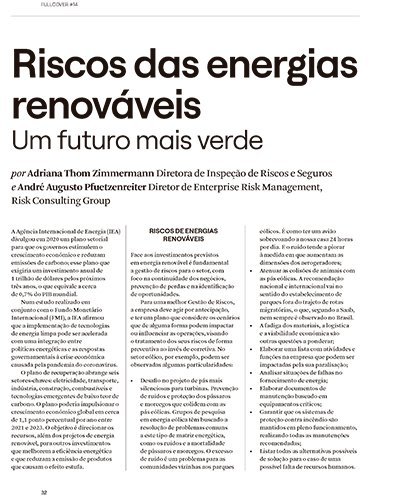Given the expected investments in renewable energy, risk management will be vital to the sector, focusing on business continuity, loss prevention and identifying opportunities.

In 2020, the International Energy Agency (IEA) shared its Sustainable Recovery Plan with governments to stimulate economic growth and cut down carbon emissions. The plan calls for an annual investment of a trillion dollars over the next three years, which amounts to 0.7% of world GDP.
In a joint study with the International Monetary Fund (IMF), the IEA stated that implementing clean energy technologies can be accelerated if governments align their energy policies with responses to the economic crisis caused by the coronavirus pandemic.
The recovery plan covers six key sectors: power, transportation, industry, construction, fuel, and emerging low-carbon technologies. The plan aims to boost world economic growth by some 1.1% a year between 2021 and 2023. The goal is to direct resources, in addition to renewable energy projects, to other investments that will improve energy efficiency and reduce greenhouse gas emissions.
THE RISKS OF RENEWABLE ENERGY
Given the expected investments in renewable energy, risk management will be vital to the sector, focusing on business continuity, loss prevention and identifying opportunities.
Effective risk management requires companies to anticipate risk and develop a policy that predicts scenarios that could impact or influence their day-to-day operations, taking a preventative rather than corrective approach. In the wind energy sector, for example, challenges include:
•Developing quieter turbine fans, reducing noise, and protecting the birds and bats that fly into the blades. Research groups are looking at how these problems can be addressed during the production process; particularly as excess noise is a problem for neighbouring communities and industrial sites. It is like having a plane flying over your house 24 hours a day, and the noise increases proportionally to generator size.
•Reducing the number of animal collisions with turbine fans. National and international guidelines recommend wind farms are commissioned outside migratory flight paths which, as Saab points out, does not always happen in Brazil.
•Considering material fatigue, logistics and economic viability.
•Listing company activities and functions impacted by a shutdown.
•Analysing interruptions to the power supply.
•Drafting maintenance documents for key plant and equipment.
•Testing fire hazard equipment and systems to ensure they are functional at all times and recommending maintenance tasks.
•Identifying solutions when there is less operational support.
With biomass-based production, where ethanol is extracted from sugarcane or corn, fire and explosion hazards are significant. It is therefore important to detail all the steps necessary to secure the raw material plantations (corn or sugarcane) and ethanol, which is highly flammable, and safely handle waste, which comprises combustible organic matter.
RISK MANAGEMENT
When assessing renewable energy risks, climate factors are highly relevant.
Electricity production, for example, largely relies on the availability of natural resources, as the climate is the main determining factor in hydro, wind, and photovoltaic power, which collectively represent 90% of all renewable energy production. Wind and sun-based energy suppliers no longer sit on the side-lines; they have become mainstream industry players.
But, when mentioning risk, opportunities as well as losses must be considered. Living through the Covid-19 epidemic has led to massive changes in consumption and work habits.
During lockdowns, oil prices fell as consumption dropped and stocks grew. People working from home increased their power consumption, motivating investment in solar energy generation units.
RCG Herco provides specialist risk management support for renewable energy companies, with qualitative and quantitative risk analysis and risk assessments. Its risk mitigation plans reduce the impact of any risks to a business and avert likely threats. From a corporate perspective, the plan must be part of the company’s general strategy and linked to its risk prevention policy.
There are new opportunities in renewable energy. Companies keen to seize the moment without excessive risk exposure must structure a risk management policy that identifies, assesses, and processes the risks associated with new enterprises, thus paving the way for entrepreneurs’ and societal goals to be achieved.
Adriana Thom Zimmermann is Director of Risk Inspection and Insurance at RCG. She has a Master in Chemical Engineering in the field of Chemical and Biotechnological Process Development from the Federal University of Santa Catarina, USFC, Brazil and a post-graduate in Workplace Safety Engineering from the SOCIESC, Santa Catarina Educational Society under the Getúlio Vargas Society (FGV).
André Augusto Pfuetzenreiter is Director of Enterprise Risk Management at RCG. He has a Degree in Workplace Safety Engineering from the Regional University of Blumenau and another in Electrical Engineering from the Regional University of Blumenau, Brazil.



